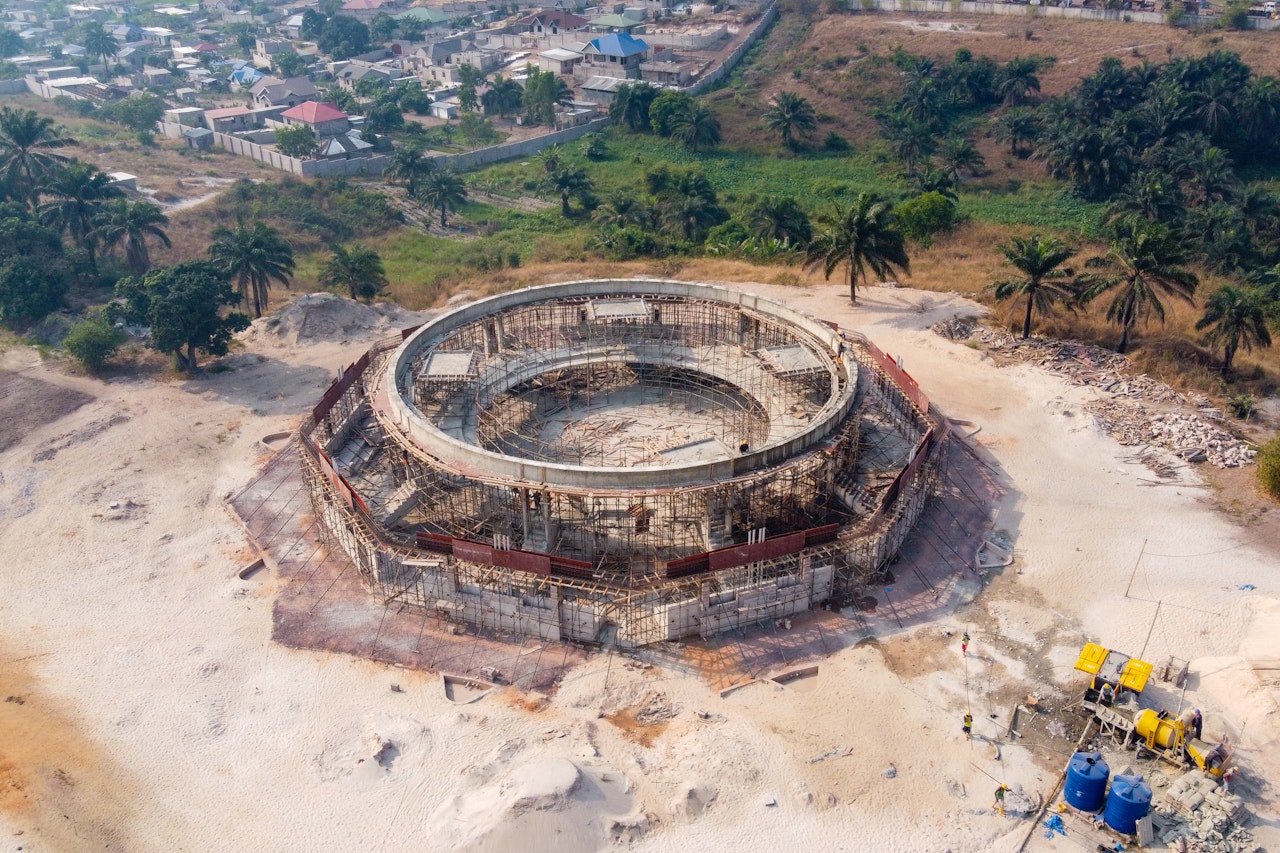“It is appearing before our eyes”
Emerging DRC temple inspires growing numbers to action
Although in its early stages, the Bahá’í temple is giving rise to greater action aimed at the material and spiritual progress of society.

Although in its early stages, the Bahá’í temple is giving rise to greater action aimed at the material and spiritual progress of society.

KINSHASA, Democratic Republic Of The Congo — Just months after the completion of the foundations of the Bahá’í House of Worship in the Democratic Republic of the Congo (DRC), striking structural elements that make up the lower portion of the central edifice are coming into view.
The rapid progress being made on the construction of the temple has gone hand in hand with greater action aimed at the material and spiritual progress of society.
“The House of Worship is appearing before our very eyes” says Lavoisier Mutombo Tshiongo, the secretary of the country’s Bahá’í National Spiritual Assembly.
He continues: “At the same time, we are seeing an intensification of action inspired by what the temple represents. Everything is increasing, from devotional gatherings, educational efforts, and other initiatives taken by families and youth, such as cleaning rivers and water sources, to formal activities in the areas of food security and agriculture, education, health and empowerment of women.”
Mr. Tshiongo attributes the increasing pace of activity to a growing appreciation of the relationship between worship of God and service to humanity that is being cultivated through conversations about the national House of Worship, which is situated on the outskirts of Kinshasa.
Anis, a youth from the Bahá’í community of Lubumbashi, reflects on the relationship between service and worship, stating: “When people visit the House of Worship to pray, even though it is still under construction, they leave having become more clear about the actions they wish to take, because immersing yourself in prayer and meditation creates a sense of spirituality. In those moments, we see what is important in life—to become a source of social good and be of help to our fellow citizens.”
The effects of the emerging House of Worship have been felt not only by area residents who have been able to visit the site, but also by people much further away.
Mr. Tshiongo explains that the National Spiritual Assembly has been stimulating many discussions about the House of Worship—referred to in the Bahá’í writings as a Mashriqu’l-Adhkár, meaning “Dawning-place of the Praise of God”—through a series of gatherings across the DRC, conducted in compliance with government safety measures.
Speaking at a recent gathering in Baraka, South Kivu, Chief M’muwa Lwe’ya Aolōélwa II described how Bahá’í temples call to mind memories of the lubunga—a space dedicated to prayer and discussion on community matters among village elders.
“The lubunga, which has nearly disappeared from modern life, provides space for village elders to pray to God and ask for guidance as they assist with community matters. Today, we are learning about the Mashriqu’l-Adhkár—a center where all men, women, and children can gather as one and connect with their Creator.”
Progress on the construction work is featured in the gallery of images below.
Since the temple’s foundations were completed in February, workers have been raising the concrete structural elements that make up the lower portion of the edifice and will support the steel superstructure of the dome and surrounding canopies.
The upper gallery level has been built, supported by nine struts that will also serve as staircases. The dome will be anchored at nine points around the gallery.
The struts will direct the weight of the dome outward into the foundations, leaving the entire lower floor of the temple free of support columns.
Two ring beams have been built, one above the gallery and the other above the temple’s outer wall. At the center of this image is a space in the outer wall that will be one of the nine doorways into the temple.
Last week, the innermost of the two ring beams was completed. At 8 meters above the ground, the concrete portion of the structure has now reached its full height. More than 90 percent of the concrete for the edifice has been poured, opening the way for the steel superstructure to be erected.
Work on the grounds and auxiliary structures around the temple continues. Here, gardeners plant a lawn near the rising temple.
The walls and roof of the future visitors’ center have been completed.
In-person gatherings held according to safety measures required by the government. Area residents have been visiting the site and engaging in conversations about the House of Worship and the relationship between worship of God and service to humanity.
In-person gatherings held according to safety measures required by the government. Residents of Kinshasa have been volunteering on the temple site, assisting with many aspects of the project.
In-person gatherings held according to safety measures required by the government. Gatherings across the DRC have been stimulating many discussions about the House of Worship, which stands at the heart of the community, is open to all peoples, and is a place where prayer and contemplation inspire service to society.